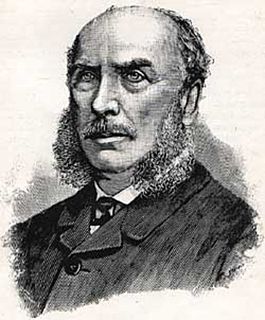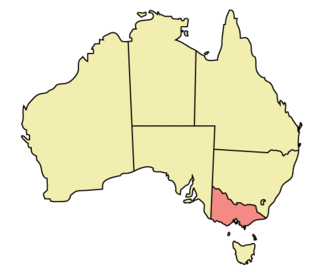
Pterostylis coccina, commonly known as the scarlet greenhood, is a species of orchid endemic to eastern Australia. As with similar greenhoods, the flowering plants differ from those which are not flowering. The non-flowering plants have a rosette of leaves flat on the ground but the flowering plants have a single flower with leaves on the flowering spike. In this species, the rosette leaves are relatively large and dark green, and the flowers are white, and bluish-green or red. It grows in New South Wales and north-eastern Victoria.

Pterostylis biseta, commonly known as the bristled rustyhood, is a plant in the orchid family Orchidaceae and is endemic to south-eastern Australia. It has a rosette of leaves at its base and up to seven relatively large, translucent flowers with green and brown marking with a brown to green insect-like labellum with bristly hairs. It occurs in New South Wales, South Australia and Victoria although in the latter state it has been separated into three species and is also under review in New South Wales.

Pterostylis cobarensis, commonly known as the inland rustyhood or Cobar rustyhood is a plant in the orchid family Orchidaceae and is endemic to Australia. It has a rosette of leaves and between two and ten hairy, green and brown flowers with translucent white "windows" and a fleshy, insect-like labellum. It grows in inland areas of eastern Australia.

Pterostylis lingua, commonly known as the large-lipped rustyhood, is a plant in the orchid family Orchidaceae and is endemic to south-eastern Australia. It has a rosette of leaves and up to ten dark reddish-brown flowers with translucent "windows" and a blackish, insect-like labellum.

Pterostylis maxima, commonly known as the large rustyhood, is a plant in the orchid family Orchidaceae and is endemic to south-eastern Australia. It has a rosette of leaves at its base and up to eight relatively large, dark brown flowers with transparent "windows" and a thin, dark insect-like labellum.

Pterostylis planulata, commonly known as the flat rustyhood, is a plant in the orchid family Orchidaceae and is endemic to Victoria. It has a rosette of leaves at its base and up to seven translucent flowers with green stripes. The flowers have a thin, dark green, insect-like labellum.

Pterostylis squamata, commonly known as the southern rustyhood or ruddyhood, is a plant in the orchid family Orchidaceae and is endemic to south-eastern Australia. Flowering plants have up to ten translucent green flowers with reddish-brown markings and a hairy, insect-like labellum. Non-flowering plants have a rosette of four to eight egg-shaped leaves. This species is very similar to Pterostylis rufa which has a narrower labellum and other minor differences.

Pterostylis hamata, commonly known as the southern hooked rustyhood, is a plant in the orchid family Orchidaceae and is endemic to eastern Australia. It has a rosette of leaves and between two and twelve transparent flowers with green and brown markings, a thick, brown, insect-like labellum and dished lateral sepals.

Pterostylis boormanii, commonly known as the Sikh's whiskers, baggy britches, or Boorroans green-hood is a plant in the orchid family Orchidaceae and is endemic to south-eastern Australia. It has a rosette of leaves and up to seven dark reddish-brown flowers with translucent "windows" and a thick, brown, bristly, insect-like labellum.

Pterostylis calceolus, commonly known as the Bungonia rustyhood, is a plant in the orchid family Orchidaceae and is endemic to New South Wales. It has a rosette of overlapping leaves and between two and seven reddish-brown flowers with transparent "windows" and a fleshy brown, insect-like labellum. It is only known from near Bungonia.
Pterostylis chaetophora, commonly known as the Taree rustyhood, tall rusthood or ruddy hood is a plant in the orchid family Orchidaceae and is endemic to eastern Australia. It has a rosette of leaves at its base and up to twelve reddish-brown flowers with translucent "windows" and a fleshy, reddish-brown, bristly, insect-like labellum.
Pterostylis ciliata, commonly known as the hairy rufous greenhood, tall rusthood or hairy rustyhood is a plant in the orchid family Orchidaceae and is endemic to the south-west of Western Australia. It has a relatively large rosette of leaves at its base and up to eight or more green and brown flowers which lean forward and have a small, fleshy, insect-like labellum covered with hairs.
Pterostylis excelsa, commonly known as the tall rustyhood, or dry land green-hood is a plant in the orchid family Orchidaceae and is endemic to South Australia. It has a rosette of leaves and when flowering, up to twenty green or brown flowers which lean forward and have a thick, fleshy, partly hairy, insect-like labellum.
Pterostylis ferruginea, commonly known as the Bangham rustyhood, is a plant in the orchid family Orchidaceae and is endemic to the border area between South Australia and Victoria. It has a rosette of leaves and when flowering, up to ten upright, dark green and translucent white flowers which have an insect-like labellum.
Pterostylis ovata, commonly known as the Gawler Range rustyhood, is a plant in the orchid family Orchidaceae and is endemic to South Australia. Both flowering and non-flowering plants have a rosette of leaves and flowering plants have up to six flowers which have transparent flanges on the petals and a striped, insect-like labellum.
Pterostylis praetermissa, commonly known as the Mount Kaputar rustyhood is a plant in the orchid family Orchidaceae and is endemic to New South Wales. It has a rosette of leaves and up to nine relatively small greenish and reddish-brown flowers with transparent "windows" and a reddish-brown, insect-like labellum.

Pterostylis pusilla, commonly known as the tiny rustyhood is a plant in the orchid family Orchidaceae and is endemic to southern Australia. It has a rosette of leaves and up to nine relatively small green and reddish-brown flowers with translucent white "windows" and a dark brown, insect-like labellum.

Pterostylis rufa, commonly known as the red rustyhood is a plant in the orchid family Orchidaceae and is endemic to south-eastern Australia. It has a rosette of leaves and up to fifteen bright reddish-brown flowers with translucent white "windows" and a dark brown, insect-like labellum. It occurs from southern Queensland to south-eastern South Australia.
Pterostylis saxicola, commonly known as the Sydney plains rustyhood, or Sydney plains greenhood, is a plant in the orchid family Orchidaceae and is endemic to New South Wales. It has a rosette of leaves at its base and up to ten reddish-brown flowers with translucent "windows", relatively wide lateral sepals with short-pointed tips and a dark brown, fleshy, insect-like labellum.
Pterostylis xerophila, commonly known as the desert rustyhood, is a plant in the orchid family Orchidaceae and is endemic to South Australia. Both flowering and non-flowering plants have a relatively large rosette of leaves. Flowering plants also have up to eight translucent white, green and reddish-brown flowers with an insect-like labellum.
























